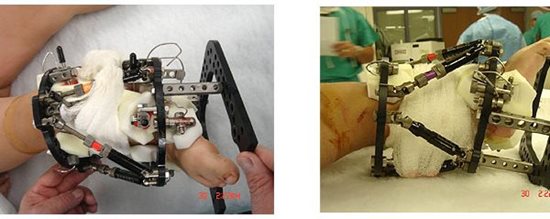Your orthopedic surgeon has chosen to use the ILIZAROV (Ill-is-are-off) method of limb correction. The ILIZAROV treatment is a highly successful orthopedic surgical technique designed to lengthen or straighten bone and soft tissue. Additionally, the ILIZAROV technique and the innovative device can sometimes save limbs that might otherwise be amputated.
Although some form of fixation has been used in orthopedic medicine for hundreds of years, it was Russian-born Gavril Ilizarov who is considered the 'father' of circular external fixators and the ILIZAROV technique. In fact, all circular external fixators today are based on Dr. Ilizarov's work from the 1950s.
Taking advantage of the remarkable fact that bone heals itself by growing, or regenerating, the ILIZAROV technique can correct disfigured bones by separating two bone halves millimeter by millimeter. During this process, the body's natural ability to grow bone fills in the gap between the two bones, correcting deformities or increasing length.

Use of the ILIZAROV Method
Limb length inequality and limb deformity can be due to many causes. The treatment plan and use of the ILIZAROV method will depend on the degree of the discrepancy, the age of the patient, and the underlying reason for the deformity.
Limb correction and ILIZAROV treatment may be prescribed for a variety of conditions:
Trauma, including:
- Growth plate fractures
- Malunion (healing of bones in an incorrect position)
- Nonunion (incomplete healing of fractured bones)
- Shortening and deformity due to bone loss
Congenital limb length discrepancies, including:
- Congenital short Femur
- Fibular hemimelia
- Pseudarthrosis of the Tibia
- Hemiatrophy/Hemihypertrophy
- and other birth defects and deformities
Pediatric hip disorders
- Developmental Coxa Cara
- Perthes Disease
- Slipped Capital Femoral Epiphyses (SCFE)
Other conditions
- Joint stiffness secondary to neuromuscular disease or following injury
- Bow legs
- Knock-knees
- Short stature (achondroplasia and other skeletal dysplasias)
- Infection involving the bone (osteomyelitis) and joint (septic arthritis)
◊ Trademark of Smith & Nephew